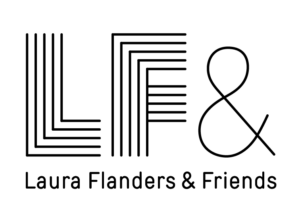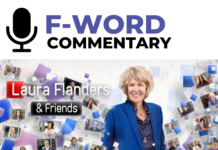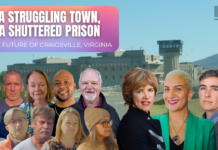Political violence is on the rise and has reached just about every corner of the country, whether it’s confrontations on social media, at school board meetings or the chambers of Congress. Reuters reports that we’ve seen some 213 cases and 39 fatalities in the U.S. since January 6, 2021 — more than we’ve seen in decades. Women, people of color, Muslims, Jews, and LGBTQ people are among those most vulnerable, but the group seeing the fastest increase in reported incidents are conservatives who are perceived to be out of sync with the pro-Trump, MAGA line. While most Americans oppose political violence, it remains a growing threat to our democracy. What can be done? In this episode, co-hosts Laura Flanders and 22nd Century Initiative Director Scot Nakagawa convene an expert panel to define political violence and discuss how to protect one another and democracy itself. All that, plus Laura’s commentary on “Reveal, Reframe, Resist” and reporters’ roles.
“As a child of a Panther, I saw inspiration in every action. Even when I saw my mother’s friends being jailed for long periods of time or even killed by police terror . . . A lot of those folks went on to continue fighting against terror of the state and building community. I wanted to be a part of that . . .” – Sala Cyril
“I undertook the study because political violence is a persistent problem in the United States that I think is a fundamental threat to our democracy. My view is that one of the greatest sources of power countering that threat is actually people in communities around the country.” – Hardy Merriman
“Violence has greatly limited our ability to function as an inclusive, robust, multiracial democracy that in fact, we must deal with it . . . We need to believe we can win, and we need to think about who it is that we need on our side . . .” – Scot Nakagawa
“I can report anecdotally through different interactions with conservatives that they are experiencing political violence. I’ve been in attendance with secretaries of state, former Lieutenant governors. They all have stories of themselves or their families being on the receiving end of political violence . . .” – Maria J. Stephan
LAURA FLANDERS & FRIENDS
Political Violence & MAGA Militancy: Strategies to Protect Democracy
LAURA FLANDERS: Democracy requires that we can make political choices and participate free from bullying, intimidation, or threats of violence. And so it is a serious problem when rates of political violence go up as they have in the US. Reuters reports that we’ve seen some 213 cases, including 39 fatalities in the US just since January 6th, 2021. And that’s more than we’ve seen in decades. Women, people of color, Muslims, Jews and LGBTQ people are among the most vulnerable, but the group suffering the fastest increase in reported incidents are actually conservatives, who are perceived to be out of sync with the pro-Trump MAGA line. What can be done? Well, it’s a cross-cutting issue. A vast super majority of Americans oppose violence in all contexts, but it also threatens every other effort to strengthen democracy and freedom. So we need to get a handle on it. For that, we have convened an expert panel and I have invited back to co-host Scot Nakagawa the Director of the 22nd Century Initiative. Scot, welcome back to “Laura Flanders and Friends.” Friend, I’m very glad to have you with me for this important conversation.
SCOT NAKAGAWA: It is very important, one of the most important topics and we’re lucky here to have a couple of experts join us to help us understand political violence and what we can do about it. Joining us are Sala Cyril, Interim Executive Director of Vision Change Win, an organization that focuses on community safety. Sala also organizes with the Malcolm X Grassroots Movement, New York Chapter. Maria J. Stephan is also here. She is the chief organizer and co-Lead of the Horizons Project, an organization focused on strengthening relationships between the social justice and peace building and democracy communities here in the United States, and very importantly globally. She’s the co-author with Erica Chenoweth of “Why Civil Resistance Works: The Strategic Logic of Nonviolent Conflict.”
LAURA FLANDERS: Let’s start with hearing a few stories. Maria, to you, when we talk about political violence, what are we actually talking about?
MARIA J. STEPHAN: So, political violence includes threats, intimidation, acts of physical violence that is used with a political motivation to achieve a political goal or to assert political power over another group. And we know that in the United States that the preponderance of acts of political violence are being committed by the far Right with a smaller number of incidents being committed by the far Left. So as you noted, you know, no one is immune from being targeted, although we know that historically marginalized communities, Black Americans, Brown Americans, LGBTQ are being disproportionately targeted with political violence in this moment, but also a number of conservatives, including those that aren’t towing the MAGA line. So it’s harming a lot of people across the country.
SCOT NAKAGAWA: And a lot of people who are unaffiliated with either political party as far as anyone’s concerned, but who are trying to, you know, basically fulfill the duties of jobs that are related to elections, et cetera. You know, people who are considered to be functionaries of government who are also viewed in opposition to the MAGA coalition, is that right?
MARIA J. STEPHAN: So I’ve been in attendance with Secretaries of State, you know, former Lieutenant Governors. They all have stories of themselves or their families being on the receiving end of political violence. And I’ve also heard about conservative librarians who, because they refuse to pull books out of the shelves, they refuse to go along with the Book Banning Movement, they are being targeted with threats, intimidation. And so I don’t doubt actually that there is a rise in the number of incidents of people from across the political and ideological spectrum, who are being targeted with these threats because it has become mainstreamed and on a particular part of the political spectrum in this country, it has been endorsed or enabled actively. And that’s the difference between political violence that occurs on the Left in the US because there are incidents of political violence. However, it does not receive the endorsement of the political mainstream, the Democratic Party. That is quite different from the situation of political violence emerging from the far Right.
LAURA FLANDERS: Coming to you Sala, it’s not like political violence is a brand new occurrence in this country. I mean, go back through the history and some groups have been subject to it for centuries. I would love to get a sense from you of what you do on a daily basis work-wise, and what’s changed, what hasn’t changed in this moment for the people that you work with closely?
SALA CYRIL: Unfortunately, this is not new and we have been experiencing this level of political violence for decades and centuries, honestly. But one of the things that we do at Vision Change Win is we offer overall organizational development, but very specifically community safety support and community safety and security support to organizations and activists and leaders and people that are fearful of political violence, right? That are concerned about political violence in retribution for the work that they may be doing right? Just because we believe that creating community safety and security is everyone’s responsibility. We come from a history and a legacy of organizations like the Young Lords, like the Black Panther Party that created community safety support and techniques for people to protect themselves, not only for specific state threats, but you know, just as standard community, you know, the right level of violence was high. And then from there, the organizations, a lot of our legacy came out of New York City specific safety and security lineage groups like the Malcolm X Grassroots Movement, The Audre Lorde Project, The Coalition Against Police Brutality.
LAURA FLANDERS: The groups that you’ve mentioned and the history that you’ve described, Sala speaks to a desire to keep certain people intimidated perhaps, and out of our process. I mean, what we are talking about is a fear that people will be intimidated out of participating in the process. Is that what you’ve seen?
SALA CYRIL: Oh, definitely. Well, so a little bit of history, I won’t be long, but my mother was a member of the Black Panther Party. She was one of the co-founders of the Free Breakfast Program, right? And that was declared one of the highest threats to national security. Now the state thought that, but the people, the kinds of threats that regular people trying to get their children fed faced were high, right? The kinds of threats that we see, that we see regular everyday people face of those communities that we’re supporting, people being killed, we’re seeing things like, you know, the kinds of work that the Malcolm X Grassroots Movement does is to support groups and people that have been identified as victims of police brutality. The families are being attacked by not only the state, but also you know, the Right.
LAURA FLANDERS: We had a chance to talk with researcher Hardy Merriman. He is president of the International Center on Nonviolent Conflict and has been looking into this subject for a newly released report. He was speaking to us in an independent capacity about this reporting, and I started by asking him what he was seeing in terms of the frequency of political violence.
HARDY MERRIMAN: So when we take those two, a broad definition of violence and a narrow definition of political, what we see in the US is that for a country of 330 million people, there’s actually a fairly low incidence of physical political violence. There aren’t a lot of people who are actually being physically injured because of their expressed political viewpoints at this moment. But the dynamic of threats and intimidation is obviously skyrocketing. So that’s a real concern. And it relates to physical political violence too, because even if you have a few cases of physical political violence, it causes threats to seem credible. So the dynamic of threats is a major concern and it’s something we have to do something about. The way I look at it, there’s actually three groups that are part of this sort of ecosystem of what generates threats. And the first group are Inciters. And Inciters are people, who are trying to build a following. They’re trying to generally, they’re sort of entrepreneurial about it, trying to get political power, create a following, sometimes monetize that following. So we tend to know who Inciters are and they engage in a sort of toxic rhetoric, where they talk about their viewers as virtuous, good, upholding the highest values and so forth. And they define another group as a fundamental threat, where that group shares collective blame for all kinds of problems. And they heat up the rhetoric to the point, to the point that violence starts to seem permissible against this perceived threat group. And that if the democratic process actually delivers an election victory to that other group, then insiders normalize the idea that perhaps democracy itself is not adequate and should be undermined. Then the next group are what I call Threat Makers. This group tends to be male, tends to be according to one study by CNN, average age of about 37 years, tends to have a higher, generally higher formal education and income level than your standard sort of general criminal population. Though I would point out that because of First Amendment protections, many threats are actually not criminal in this country. And based on the data that I can read, it does seem that Threat Makers tend to lean more to the right wing. However, there are certainly Threat Makers, who are on the Left wing as well. And then the last group are actually Enactors, people who are going to do physical violence. And interestingly enough, a lot of Threat Makers don’t go on to enact political violence. And a lot of Enactors don’t necessarily make threats ahead of time. You know, for example, the man who attacked Nancy Pelosi’s husband, my understanding is he did not make threats ahead of time. The individual who shot the congressional baseball game and wounded Congressman Scalise and others, my understanding is he did not make threats ahead of time. So there are these three different groups and sometimes they overlap, but actually I think it’s helpful to think of them distinctly, but the good news is, is there are a lot more of us than there are of them. And so if political violence and threats are used to try to achieve political goals, it’s up to us to counter those political goals. We can make them by organizing less politically profitable for the people who do that.
SCOT NAKAGAWA: That was Hardy Merriman. He is the author of the guide “Harnessing Our Power to End Political Violence or HOPE.” So let’s get down to details. So what specific guidance can we offer people who are supporting someone who has been threatened or attacked or who have been threatened or attacked themselves?
SALA CYRIL: You know, the kinds of things that we teach and support and help train are about basic deescalation techniques, right? And to just to ensure that as things continue to escalate, as things continue to become a problem, that they’re able to address them, right? Also, some basic safety planning. And that includes things like, you know, building basic things like emergency contacts and making sure you share that with someone. But then also digital security support. A lot of the threats happen digitally. And not just doxing, you know, but hacking and swatting and the kinds of things that put people in real physical danger.
LAURA FLANDERS: Just to remind people, swatting is where you’re literally calling the cops in on somebody’s house and those police could arrive with arms drawn, guns drawn on the pretext that there’s something happening in that house that the police need to come to.
SALA CYRIL: Yes and then other ways like conflict support. And that sounds like, you know, a lot of times organizations though, the groups that are doing this really deep work to protect themselves, to protect their rights that are having difficulty, they need kind of organizational capacity support to ensure that they don’t crumble in the face of the kinds of threats that come from the Right, the physical threats and, you know, and maybe intangible, right? And overall really shifting the paradigm that security and safety is this white, masculine, patriarchal thing, but also really just creating security consciousness. A way to think about moving through the world and creating networks that build resiliency and allow people to lean on each other.
SALA CYRIL: But I mean that’s a lot of work for we the people. Isn’t there a role for government in all this, isn’t this why we have government? I mean, Maria, coming to you, what demands can we make of government to step in here?
MARIA J. STEPHAN: There are certainly like legal and like litigation strategies that can be deployed particularly against far Right groups. So is that kind of support being provided? Are people being, you know, being challenged within their parties when they are actively endorsing white supremacist groups or they’re actively supporting violence targeting particular groups in society? Is there that condemnation? So I think there can be, you know, things certainly that the government can do from a policy perspective. There are things governments can do, but like some governments, some state governments in this country are in the hands of anti-democratic forces right now. They’re in the hands of MAGA folks. And so if you’re hoping to use those regular advocacy channels or you know, litigation channels, it may not be effective. And that’s why we need communities, and communities across this country are doing it. They are going after folks that are targeting gay pride parades through various organization with religious leaders and veterans groups and businesses, who have been involved in kind of anti-white supremacist campaigns. You have, like in Enid, Oklahoma, one of their city council members was Judd Blevins, who was, you know, was found to be marching with the Neo-Nazis in Charlottesville in 2017. The community mobilized, they got a recall election, they ousted him, another Republican, a woman, an educator who wanted to restore the town’s reputation stood up, fought back. And that’s how we win. We organize, we plan, we prepare, and we use methods that they’re not prepared for and that will disarm them. And that’s the greatest strength I think of, of the movements across this country.
LAURA FLANDERS: Sala coming back to you again for a second on this because I’m very struck by your story. You know, you started by saying this is personal for you because your mother was herself targeted, and yet the reaction of you and your sister has been to become very visible, very leading activists in exactly this area. So I would love to hear from you what turned it into inspiration for you and stimulus for you to get involved, as opposed to get your head down, get out of this and go and find somewhere out of view to be.
SALA CYRIL: I mean, I honestly, as a child of a Panther, I saw inspiration in every action. Even when I saw, you know, my mother’s friends being jailed for long periods of time or even killed by, you know, police terror. The kinds of stories that came out of their work, the kinds of inspiration, the kinds of movement and changes that they were able to make in the small period of time that they were in action was so inspiring. Not just that, but a lot of those folks because it, you know, it’s my family, right? I was raised in, you know, with the Panther Party as my family, a lot of those folks went on to continue fighting against terror of the state and you know, building community. And I wanted to be a part of that.
LAURA FLANDERS: So that goes back to storytelling. It seems to me we can get inspired by the stories that are inspiring as opposed to the stories that just constantly terrify us to death. That’s where the media come in. Maria, you have written extensively covering inspiring stories of civil disobedience in the face of life-threatening violence in this country and internationally, share some of that will you and what’s its relevance for today?
MARIA J. STEPHAN: You know, when I’m referring to civil resistance or nonviolent resistance that’s used to apply pressure on the opponent, economic pressure, political, social, financial, and raise the price, like raise the cost and the price of repression and authoritarianism without the threat or the use of violence and the reason why nonviolent resistance in this country and around the world – and yes, I’ve spent a good chunk of the past quarter century working with and writing about movements around the world that have challenged various forms of authoritarianism. Kind of what we know is that movements succeed when they attract mass diverse participation. So you really do need people from different parts of society, different sectors. You need people who are ideologically different, who are politically different, who are laborers, who are professionals, who are young people. We know that movements that are able to tap into a diverse array of tactics. So they don’t just keep doing the same thing, they don’t just go out into the street and demonstrate or march, they do tactics like walkouts. They do pressure tactics like consumer boycotts or you know, other acts of non-cooperation. Strikes, which have been one of the most powerful general strikes, whether it was in Chile, whether it was in South Africa, other countries, have been the most powerful tactics to push back against authoritarianism. So what successful nonviolent resistance movements do is they systematically pull those pillars away from an autocrat so that they’re like emperors with no clothes. They no longer have their moral and material support. Like they’ve actually targeted pillars that are enabling violent authoritarianism with strikes, boycotts, pressure.
SCOT NAKAGAWA: You know, one of the things that I remember you saying once is that it only takes about 3.5% of people to engage in a sustained mass mobilization to basically affect regime change. So give us some hope. What does that look like?
MARIA J. STEPHAN: I mean, let’s just say 3.5% of any population is a large number of people, so you don’t want to underestimate. So yes, and this is, you know, my colleague Erica Chenoweth, who’s a professor, professor of government at Harvard University, ran, crunched the numbers after as part of our research from “Why Civil Resistance Works.” And Erica, they found that no regime has remained in power when 3.5% of the population has engaged in active protest. You know, and it’s very hard to reach 3.5%. Of course, I’m trying to think, I think the Women’s March, for example, in 2017 got somewhere close to 2% maybe, or just over 2%. However, the Movement for Black Lives, so after you know, Ahmaud Arbery, Breonna Taylor, George Floyd were murdered, and in the summer of 2020, you had the largest and most sustained protests and demonstrations in US history. And this didn’t happen magically, right? It was the result of years of organizing by the Movement for Black Lives and the coalition that came together. So there were like so many people participating in different ways and you know, has it ended racial injustice in this country? Absolutely not. However, it was a massive, a moment of reckoning in this country. It has led to different types of organization, different pressure points on police departments and other kind of entities that were enabling white supremacy, racism in this country. But that was enabled through organization. And that’s another key lesson I think with all this. Like you get to 3.5% by organizing and by investing in institutions that allow you to maintain resilience when the violence comes, because the violence will come. It always comes to those who challenge political power.
MARIA J. STEPHAN: By the way, when you said 3.5%, that’s what it takes. I have done my research, according to a number of different, you know, credible research sites, and this includes, you know, the Pew Charitable Center, the Pew Research Center, the range in terms of estimates of how many people in the US public participated in the mobilization during the pandemic goes from 6% to 10% right? Now they don’t define participation very well, but that’s still something to build upon, right? And we have the movement for Black Lives and all of the years and years and decades of struggle before that to thank for that and to use as a guide for how we can continue to build on that number and create the support needed, the infrastructure, the people to sustain it for long enough for it to finally be able to achieve the kind of ends that we need to achieve.
LAURA FLANDERS: Beautiful. Thank you all. Maria Stephan, Sala Cyril, Scot Nakagawa, it’s always a pleasure to be with you. Thanks for co-hosting this conversation. I’ll be back with a few thoughts after this.
There’s more and more evidence that politics is personal. Not just in the sense that at the end of the day faced with your ballot, it’s your choice alone, but in the sense that we vote for the candidate who we think will do the most for our family and ourselves and our communities. It’s personal too, in the sense that we tend to follow pundits that feel like members of our tribe and tune into the cable channel that feels that way too. And if all else fails, well we listen to our friends and vote the way our families did. So it is personal. And here’s an experiment. What if every time you heard the word political as in political violence, you substitute the word ‘personal’. I thought about that recently as I thought about Stanley, my young nephew, who this summer is spending some of his time canvassing in the British elections. I got my start talking to strangers about politics at about that age, doing that exact same thing. It was safe in my day pretty much. And I’m thinking it’s still pretty safe in his, but if it wasn’t, if it wasn’t safe for him to go out and knock on strangers doors and talk about politics, I’d take that personally, wouldn’t I? And wouldn’t I do something about it? And what if we didn’t think about talking about politics, but talking about personal matters, which after all politics is, it’s just the personal turned collective. You can find my full conversation with every week’s show guests through a subscription to our podcast. You get all the uncut interviews. You can get all the information about the podcast at our website. Thanks for watching. Till the next time, stay kind, stay curious. For “Laura Flanders and Friends,” I’m Laura.
For more on this episode and other forward-thinking content, subscribe to our free newsletter for updates, my commentaries and our full uncut conversations. We also have a podcast. It’s all at LauraFlanders.org.
“Why Civil Resistance Works: The Strategic Logic of Nonviolent Conflict” by Erica Chenoweth & Maria J. Stephan: Get the Book
•. Two-Thirds in US fear violence could follow election, Reuters/Ipsos poll finds, by Jason Lange and Andy Sullivan. Read Here
“Intensity in Five” by Brkn Record featuring Antohony Joseph from his album The Architecture of Oppression Part 2 released on Barely Breaking Even Records, BBE. Listen & Learn More
Laura Flanders & Friends is committed to making our programming, website and social media as accessible as possible to everyone, including those with visual, hearing, cognitive and motor impairments. We’re constantly working towards improving the accessibility of our content to ensure we provide equal access to all. If you would like to request accessibility-related assistance, report any accessibility problems, or request any information in accessible alternative formats, please contact us.
















